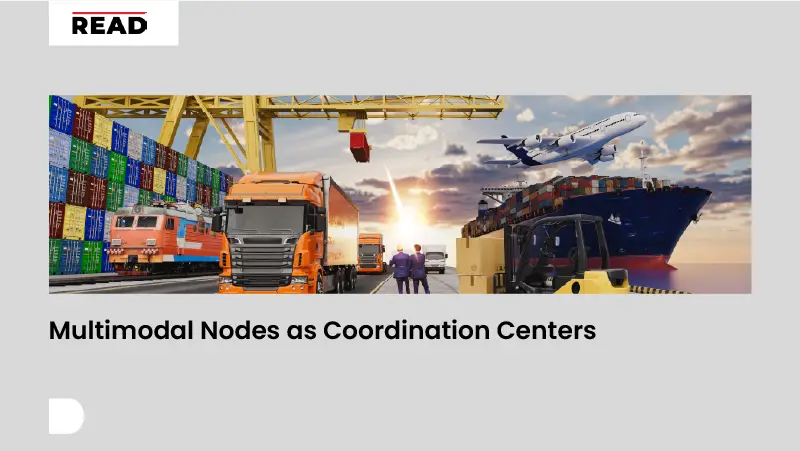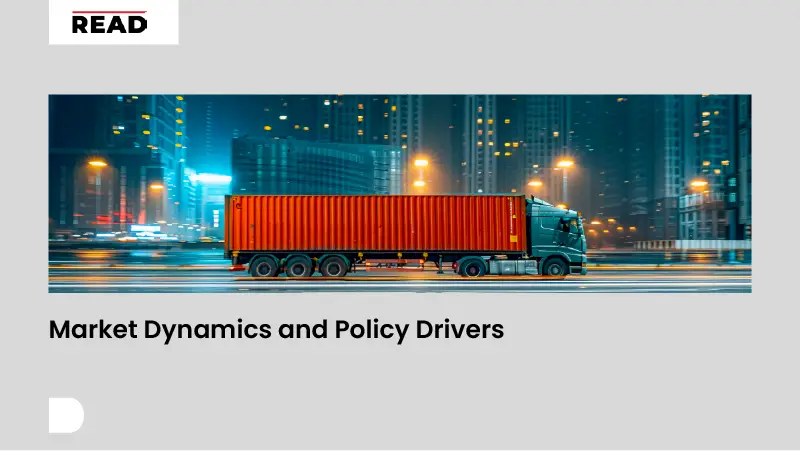Moving goods under a single contract utilizing two or more modes such as air, sea, rail, or road, is known as multimodal transportation. The process is managed by a single operator from start to finish, streamlining accountability, paperwork, and communication. This enables global trade by providing more flexibility and coordination across modes.
For transport systems to manage supply chain disruptions, freight must be easily redirected. These include port congestion, infrastructure failures, or geopolitical crises. Multimodal logistics distributes risk over several travel legs, resulting in operational robustness. To cut expenses, environmental effect, and inefficiencies, multimodal systems are being invested in by governments, shippers, and infrastructure developers.
Modal Integration in Practice
Each mode in a multimodal network serves a specific purpose based on distance, cost and cargo type. Rail and sea handle long haul and bulk. Trucks manage short haul between ports, terminals and final delivery points. Air is for high value or time sensitive shipments.
In 2022, rail made up 17.1% of all inland freight transportation in the EU in terms of tonne-kilometers. The region’s continuous investment in intermodal terminals, coordinated transportation policy, and environmental restrictions that promote the transition from road to rail are all reflected in this share.
Benefits for Modern Supply Chains
Multimodal transport offers flexibility in routing when one mode is disrupted. Cargo can be shifted between rail and road or between sea and inland waterways to meet delivery schedules.
Energy efficiency is a big plus. The US Department of Transportation’s Federal Railroad Administration says a freight train can move one ton of cargo 470 miles on one gallon of fuel.
Also Read: What Nuclear Waste Management Means for Industrial Partners in the Energy Supply Chain
This is why rail is a key part of sustainable logistics. When combined with other modes it reduces transportation costs and emissions over long distances.
The Strategic Role of Multimodal Logistics in Supply Chain Architecture
Facilitating Integrated Mobility Throughout Various Regions
Supply chains stretch across continents, time zones and regulatory systems. Multimodal transport creates one system that ties all those fragmented environments together. By combining the best of each mode supply chains can navigate infrastructure variability, weather delays and geopolitical risks without being tied to one network. This cross modal integration allows for stable freight movement across countries with varying levels of development and connectivity.
This cross modal integration enables freight to move across countries with varying levels of development and connectivity. A well executed multi modal strategy minimizes inventory and reduces response time across the distribution layers. As global production moves towards nearshoring and regionalization, multi modal networks are key to establishing reliable trade lanes between inland manufacturing zones and maritime ports. These connections keep production running and service level agreements in place even in volatile market conditions.
Multimodal Nodes as Coordination Centers

The success of multi modal systems relies on the design and functionality of the interchange nodes. These are the physical spaces where cargo is transferred between modes such as from rail to road or from sea to truck. Terminals, dry ports and inland clearance depots are high volume sortation points that absorb variability from the transport system and smooth out the handover process.
At these nodes operational coordination must match physical infrastructure capability. Efficient crane systems, dockside handling and containerized interfaces reduce turnaround time and congestion. Digital platforms integrated into terminal operations allow for cargo pre clearance, route optimization and coordination with customs and border authorities. These combined elements are what give multi modal systems the ability to scale.
Technology as an Enabler of Multi Modal Efficiency
Beyond infrastructure technology plays a key role in harmonizing the operational flow of multi modal logistics. Shipment visibility platforms, digital transport documents and predictive analytics improve coordination between shippers, carriers and regulators. As shipments move from one mode to another these tools ensure every stakeholder along the chain has real time access to location, condition and handling instructions.
Transport management systems (TMS), warehouse management systems (WMS) and customs automation platforms are now being embedded into national logistics strategies and trade corridor development plans to increase system responsiveness and reduce compliance delays. This digital layer creates a common operational language between private operators and public authorities.
Multi Modal Logistics in Risk Management
Multi modal logistics is no longer a niche approach for special cargo. This approach is now widely used to manage risks in global supply chains.
It allows businesses to respond to unexpected disruptions, like port delays, natural disasters or regulatory changes. Having multiple transport options means you can control pricing and service levels.
This is especially important in industries like pharmaceuticals, electronics and food. These industries have time critical deliveries and products that require special handling. By building multimodal agility into your logistics you can respond faster to changes. It also helps you navigate complex and unpredictable supply chain challenges. So multimodal infrastructure is key to overall business resilience.
Infrastructure and Coordination
Investment in multimodal hubs is necessary for seamless transitions between modes of transportation. These cover dry ports, inland ports, and intermodal terminals. These facilities use standard containers and automated tools. This helps move cargo quickly and with little delay.
The EU’s Trans-European Transport Network (TEN-T) connects road, rail, and port infrastructure across member states. National logistics policies in the U.S., Germany, and Japan focus on integrated systems. They aim to reduce cargo dwell times and boost throughput.
Digital platforms enhance coordination between modes. Real-time tracking, electronic waybills, and customs integration help cut delays. They also boost shipment transparency around the world.
Market Dynamics and Policy Drivers

Despite economic challenges, the global container trade is expected to increase. A UNCTAD analysis states that containerized trade volumes grew by 1.2% in 2023 and are expected to grow at an around 3% annual rate in 2024–2028. This steady expansion highlights the ongoing requirement for effective freight networks that can manage small rises in trade volumes while enhancing sustainability.
Regulatory and Strategic Frameworks
The goals of modal integration are reinforced by regulatory actions. To achieve modal shift targets, the EU’s Sustainable and Smart Mobility Strategy promotes investment in many projects. This encompasses inland waterways, rail lines, and intermodal infrastructure. Efficient cross-border operations are supported by the adoption of TEN T standards and standardized digital freight regulations.
Conventions like the UN Convention on Multimodal Transport of Goods and UNECE’s e CMR protocol promote electronic waybills and standardized documentation on a worldwide scale. Especially when used across international borders, these tools lessen friction in multimodal chains.
Structural Barriers and Constraints
One major issue is infrastructure shortages. The duration of cargo transfers and operational risk are increased when inland terminals and multimodal hubs are not used or are used insufficiently. Machine coordination across distinct modal segments remains complex in regions lacking integrated infrastructure.
Regulatory fragmentation also impedes seamless operations. Differing customs protocols, licensing requirements, and modal standards increase legal and financial uncertainty. These inconsistencies hinder participation in multimodal supply chains, especially for small and medium‑sized shippers.
Outlook for Global Multimodal Logistics
Multimodal transportation is poised to expand in relevance as trade volumes grow and environmental policies tighten. The UNCTAD‑projected rise in global container trade and the EU’s modal shift targets signal a continuing push toward integrated transport systems.
Shared infrastructure development, supported by public‑private collaboration and digital platforms, will be essential. Whether multimodal systems can efficiently handle increasing demand will depend on uniform handling methods, unified documentation, and real-time cargo visibility.
Multimodal logistics provides an organized route to sustainability, cost effectiveness, and resilience. Government frameworks and binding policy goals help the transport system grow. They aim for a more interoperable and resilient model.
Conclusion
Multimodal transportation offers key benefits. It combines rail, road, sea, and air for better efficiency. This approach provides more flexibility and lowers emissions. Plus, it uses unified management for strategic advantages. While EU policy sets lofty aims to transition inland freight away from roads, UNCTAD shows continuing growth in container traffic. All of these facts point to the increasing importance of multimodal systems in contemporary supply chains.




